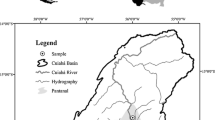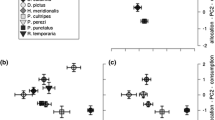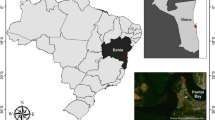Abstract
A comparative study of American alligator (Alligator mississippiensis) growth rates was made in estuarine and palustrine wetlands in southwestern Louisiana. In the estuarine wetlands, where characteristic salinity levels were ≤5%, alligators grew faster and therefore reached sexual maturity earlier than did those in palustrine wetlands, which are characterized by shallow, freshwater marsh vegetation. Slower growth rates in palustrine wetlands appeared to be related to prey density, indicated by previous studies to be lower than in estuarine wetlands. Males grew faster than females and therefore reached sexual maturity at an earlier age in both habitats. This study revealed a major limitation in using total lengths as an index upon which population age structure can be based even when alligators are in the same geographic region.
Similar content being viewed by others
Explore related subjects
Discover the latest articles and news from researchers in related subjects, suggested using machine learning.Literaturer Cited
Andrews, R. M.. 1982. Patterns of growth in reptiles, p. 273–305.In C. Gans and F. H. Pough (eds.), Biooplogy of the Reptilia, Vol. 13. Academic Press, New York.
Bara, M. O. 1972. Alligator research project. Annual Progress Report of South Carolina Wildlife and Marine Resources Department, Columbia, South Carolina. 27 p.
Carbonneau, D. A. 1987. Nesting ecology of an American alligator population in a freshwater coastal marsh. M.S. Thesis, Louisiana State University, Baton Rouge, Louisiana. 53 p.
Chabreck, R. H. 1963. Methods of capturing, marking, and sexing alligators.Proceedings of the Annual Conference of the Southeastern Association of Game and Fish Commissioners 17:47–50.
Chabreck, R. H. 1965. The movement of alligators in Louisiana.Proceedings of the Annual Conference of the Southeastern Association of Game and Fish Commissioners 19:102–110.
Chabreck, R. H. 1971. The foods and feeding habits of alligators from fresh and saline environments in Louisiana.Proceedings of the Annual Conference of the Southeastern Asociation of Game and Fish Commissioners 25:117–123.
Chabreck, R. H. andT. Joanen. 1979. Growth rates of American alligators in Louisiana.Herpetologica 35:51–57.
Cowardine, L. M., V. Carter, F. C. Golet, and E. T. LaRoe. 1979. Classification of wetlands and deepwater habitats of the United States, United States Fish and Wildlife Services, FWS/OBS-79/31. Washington, D.C. 103 p.
Davidson, R. B. andR. H. Chabreck. 1983. Fish, wildlife, and recreational values of brackish marsh impoundments, p. 89–114.In R. J. Varnell (ed.), Proceeding of the Water Quality and Wetlands Management Conference. Tulane University, New Orleans, Louisiana.
Delany, M. F. andC. L. Abercrombie. 1986. American alligator food habitats in north central Florida.Journal of Wildlife Management 50:348–353.
Dietz, D. C. 1979. Behavioral ecology of young American alligators. Ph.D. Dissertation, University of Florida, Gainesville, Florida. 152 p.
Fabens, A. J. 1965. Properties and fitting of the von Bertalanffy growth curve.Growth 29:265–289.
Fogarty, J. M. andJ. D. Albury. 1967. Late summer foods of young alligators in Florida.Proceedings of the Annual Conference of the Southeastern Game and Fish Commissioners 21:220–222.
Gibbons, J. W., R. D. Semlitsch, J. L. Greene, andJ. P. Schubauer. 1981. Variation in age and size at maturity of the slider turle (Pseudemys scripta).American Naturalist 117: 841–845.
Giles, L. W. andV. L. Childs. 1949. Alligator management of the Sabine National Wildlife Refuge.Journal of Wildlife Management 13:16–28.
Hines, T. C., M. J. Fogarty, andL. C. Chappel. 1968. Alligator research in Florida: A progress report.Proceedings of the Annual Conference of the Southerastern Association of Game and Fish Commissioners 22:166–180.
Jacobsen T andJ. A. Kushlan. 1989. Growth dynamics in the American alligator (Alligator mississippiensis).Journal of Zoology 219:309–328.
Joanen, T. andL. McNease. 1977. Alligator diets in relation to marsh salinity.Proceedings of the Annual Conference of the Southeastern Association of Fish and Wildlife Agencies 31:36–40.
Joanen, T. andL. McNease. 1980. Reproductive biology of the American alligator in Southwest Louisiana, p. 153–159.In J. B. Murphy and J. T. Collins (eds.), Reproductive Biology and Diseases of Captive Reptiles. Society for the Study of Amphibians and Reptiles. Oxford, Ohio.
Joanen, T. andL. McNease. 1987. Alligator farming research in Louisiana, USA, p. 329–340.In G. W. Webb, S. C. Manalis, and P. J. Whitehead (eds.), Wildlife Management: Crocodiles and Alligators. Surrey Beaty and Sons, Chipping Norton, New South Wales, Australia.
Joanen, T. andL. McNease. 1989. Ecology and physiology of nesting and early development of the American alligator.American Zoologist 29:987–998.
King, R. B. 1986. Population ecology of the Lake Erie water snake,Nerodia sipedon insularum.Copeia 1986:757–772.
Klause, S. 1984. Reproduction characteristics of the American alligator in North Carolina. M.S. Thesis, North Carolina State University, Raleigh, North Carolina. 85 p.
Linscombe, G. andN. Kinler. 1985. Fur harvest and distribution in coastal Louisiana, p. 187–199.In C. F. Bryan, P. J. Zwank, and R. H. Chabreck (eds.) Proceedings of the Fourth Coastal Marsh and Estuary Management Symposium. Louisiana State University, Baton Rouge.
Madsen, T. 1983. Growth rates, maturation and sexual size dimorphism in a population of grass snakes,Natrix natrix, in southern Sweden.Oikos 40:277–282.
McIlhenny, E. A. 1934. Notes on incubation and growth of alligators.Copeia 1934:80–88.
McNease, L. andT. Joanen. 1978. Distribution and relative abundance of the alligator in Louisiana coastal marshes.Proceedings of the Annual Conference of the Southeastern Association of Fish and Wildlife Agencies 32:182–186.
Nichols, J. D., L. Viehman, R. H. Chabreck, and B. Fenderson. 1976. Simulation of a commercially harvested alligator population in Louisiana. Louisiana Agricultural Experiment Station Bulletin 691, Baton Rouge, Louisiana. 59 p.
Lalmisano, A. W. 1973. Habitat preferences of waterfowland fur animals in the northern Gulf Coast marshes, p. 163–190.In R. H. Chabreck (ed.), Proceedings of the Second Coastal Marsh and Estuary Management Symposium. Louisiana State University, Baton Rouge, Louisiana.
Perry, W. G. 1976. Standing crop of fishes of an estuarine area in southwestern Louisiana.Proceedings of the Annual Conference of the Southeastern Association of Fish and Wildlife Agencies 30:71–81.
Perry, W. G., T. Joanen, andL. McNease. 1970. Crawfishwaterfowl, a multiple use concept for impounded marshes.Proceedings of the Annual Conference of the Southeastern Association of Game and Fish Commissioners 24:506–519.
Powell, G. L. andA. P. Russell. 1984. The diet of the eastern short-horned lizard (Phrynosoma douglassi brevirostre) in Alberta and its relationship to sexual size dimorphism.Canadian Journal of Zoology 62:428–440.
Rootes, W. L. 1989. behavior of the American alligator in a Louisiana freshwater marsh. Ph.D. Dissertation, Louisiana State University, Baton Rouge, Louisiana. 107 p.
SASInstitute, Inc. 1985. SAS Users Guide: Statistics. SAS Institute, Inc., Cary, North Carolina. 584 p.
Schulte, D. M. 1989. The effects of habitat on temperature-dependent sex determination in the American alligator. M.S. Thesis, Louisiana State University, Baton Rouge, Louisiana. 150 p.
Steel, R. G. D. andJ. H. Torrie. 1980. Principles and Procedures of Statistics. McGraw-Hill Book Co., New York. 633 p.
Taylor, D. andW. Neal. 1984. Management implications of size-class frequency distributions in Louisiana alligator populations.Wildlife Society Bulletin 12:312–318.
Turner, D. D. 1966. Distribution and abundance of fishes in impoundments of Lacassine and Sabine National Wildlife Refuges. M.S. Thesis, Louisiana State University, Baton Rouge, Louisiana. 52 p.
United States Army Corps of Engineers 1974. Fish and wildlife study of the Louisiana coastal area and the Atchafalaya Basin Floodway. United States Army Corps of Engineers, New Orleans, Louisiana. 727 p.
Valentine, J. M., Jr.,J. R. Walter, K. M. McCartney, andL. M. Ivy. 1972. Alligator diets on the Sabine National Wildlife Refuge, Louisiana.Journal of Wildlife Management 36:809–815.
von Bertalanffy, L. 1960. Principles and theory of growth, p. 237–259.In W. W. Nowinski (ed.), Fundamental Aspects of Normal and Malignant Growth. Elsevier, Amsterdam, The Netherlands.
Webb, G. J. W., H. Messel, J. Crawford, andM. J. Yerbury. 1978. Growth rates ofCrocodylus porosus (Reptilia: Crocodilia) from Arnhem Land, Northern Australia.Australian Wildlife Research 5:385–399.
Webb, G. J. W., R. Buckworth, andS. C. Manolis. 1983.Crocodylus johnstoni in the McKinley River Area, N.T. III. Growth, Movement and the Population Age Structure.Australian Wildlife Research 10:383–401.
Wilkinson, P. M. 1983. Nesting ecology of the American alligator in coastal South Carolina: A study completion report. South Carolina Wildlife and Marine Resources Department, Charleston, South Carolina. 113 p.
Wolfe, J. L., D. K. Bradshawa, andR. H. Chabreck. 1987. Alligator feeding habits: New data and a review.Northeast Gulf Science 9:1–8.
Author information
Authors and Affiliations
Rights and permissions
About this article
Cite this article
Rootes, W.L., Chabreck, R.H., Wright, V.L. et al. Growth rates of American alligators in estuarine and palustrine wetlands in Louisiana. Estuaries 14, 489–494 (1991). https://doi.org/10.2307/1352272
Received:
Accepted:
Issue Date:
DOI: https://doi.org/10.2307/1352272




